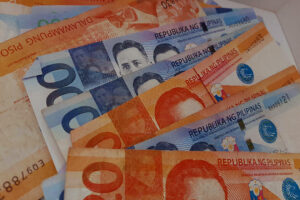




Monthly Economic Update: One for the road
 DOWNLOAD
DOWNLOAD

Inflation Update: Still low, still slow
 DOWNLOAD
DOWNLOAD

Philippines Trade Update: Exports momentum continues
 DOWNLOAD
DOWNLOAD


Gross borrowings drop 31% in April

The National Government’s (NG) gross borrowings fell in April as domestic and external debt declined, data from the Bureau of the Treasury (BTr) showed.
BTr data showed that the NG’s total gross borrowings dropped 31.3% to PHP 89.202 billion in April from PHP 129.906 billion in the same month a year ago.
Month on month, gross borrowings slumped by 57% from PHP 207.265 billion in March.
Domestic borrowings accounted for the bulk or 92% of overall gross debt during the month.
Gross domestic debt dropped by 14.3% to PHP 82.36 billion in April from PHP 96.127 billion in the same month in 2023.
Broken down, domestic borrowings were composed of PHP 67.258 billion in fixed-rate Treasury bonds and PHP 15.102 billion in Treasury bills.
Meanwhile, gross external debt plunged by 79.7% to PHP 6.842 billion during the month from PHP 33.779 billion a year ago.
In April, gross external borrowings were entirely composed of new project loans.
Rizal Commercial Banking Corp. Chief Economist Michael L. Ricafort said that the boost in tax collections in April offset the need for the government to resort to borrowings.
The Bureau of Internal Revenue collections rose by 12.65% to PHP 378.5 billion during the month. This as the deadline for the filing of annual income tax returns and first-quarter value-added tax returns was in April.
“Relatively lower amount of matured National Government debt in April also reduced the need to borrow to fund maturing debt,” Mr. Ricafort added.
Meanwhile, in the January-April period, gross borrowings rose by 7.9% to PHP 1.16 trillion from PHP 1.08 trillion in the year-ago period.
Gross domestic borrowings jumped by 38.7% to PHP 1.04 trillion in the first four months from PHP 749.113 billion a year earlier.
Domestic debt consisted of PHP 584.861 billion in retail Treasury bonds (RTBs), PHP 377.258 billion in fixed-rate Treasury bonds and PHP 76.822 billion in Treasury bills.
In February, the government raised a record PHP 584.86 billion from its offering of five-year RTBs.
On the other hand, gross external debt plummeted by 62.3% to PHP 124.099 billion as of end-April from PHP 328.883 billion a year ago.
This was made up of PHP 95.435 billion in program loans and PHP 28.664 billion in new project loans.
“Future government borrowings would also be a function of the budget deficit performance for the coming months,” Mr. Ricafort said.
The NG posted a PHP 42.7-billion budget surplus in April, though this was 36.03% smaller than the PHP 66.8-billion surplus a year ago.
In the January-April period, the budget deficit widened by 12.66% to PHP 229.9 billion from the PHP 204.1-billion gap a year earlier.
“Government borrowings for the coming months would also be timed with possible Fed and local policy rate cuts later in 2024 and 2025,” Mr. Ricafort said.
Bangko Sentral ng Pilipinas Governor Eli M. Remolona, Jr. has signaled that the central bank could begin its policy easing cycle as early as August this year.
The Monetary Board kept its benchmark rate at a 17-year high 6.5% for a fifth straight meeting earlier this month.
The central bank has raised borrowing costs to a cumulative 450 basis points (bps) from May 2022 to October 2023.
The government’s borrowing program is set at PHP 2.57 trillion for 2024, of which 75% will come from domestic sources.
The government borrows from local and external sources to help fund a budget deficit capped at 5.6% of the gross domestic product this year, equivalent to PHP 1.48 trillion. — Luisa Maria Jacinta C. Jocson
This article originally appeared on bworldonline.com





 By BusinessWorld
By BusinessWorld